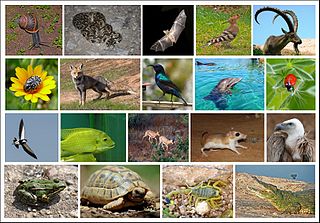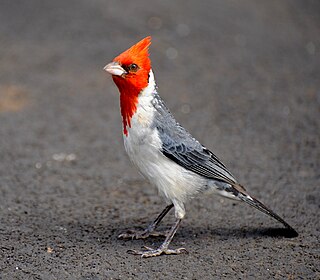
The ʻelepaios are three species of monarch flycatcher in the genus Chasiempis. They are endemic to the Hawaiian Islands, and were formerly considered conspecific. They measure 14 cm long and weigh 12–18 g. One species inhabits the Big Island, another Oʻahu and the third Kauaʻi. Being one of the most adaptable native birds of Hawaiʻi, no subspecies have yet become extinct, though two have become quite rare.

The Hawaiian crow or ʻalalā is a species of bird in the crow family, Corvidae, that is currently extinct in the wild, though reintroduction programs are underway. It is about the size of the carrion crow at 48–50 cm (19–20 in) in length, but with more rounded wings and a much thicker bill. It has soft, brownish-black plumage and long, bristly throat feathers; the feet, legs, and bill are black. Today, the Hawaiian crow is considered the most endangered of the family Corvidae. They are recorded to have lived up to 18 years in the wild, and 28 years in captivity. Some Native Hawaiians consider the Hawaiian crow an ʻaumakua.

The Pentatomoidea are a superfamily of insects in the Heteroptera suborder of the Hemiptera order. As Hemiptera, they share a common arrangement of sucking mouthparts. The roughly 7000 species under Pentatomoidea are divided into 21 families. Among these are the stink bugs and shield bugs, jewel bugs, giant shield bugs, and burrower bugs.

The Caribbean monk seal, also known as the West Indian seal or sea wolf, was a species of seal native to the Caribbean which is now believed to be extinct. The main predators of Caribbean monk seals were sharks and humans. Overhunting of the seals for oil and overfishing of their food sources are the established reasons for the seals' extinction.

The piebald shrew is a shrew found in the Turan Lowland east of the Caspian Sea in Iran, Turkmenistan and Uzbekistan.

The Kauaʻi ʻōʻō or ʻōʻōʻāʻā was the last member of the ʻōʻō (Moho) genus within the Mohoidae family of birds from the islands of Hawaiʻi. The entire family is now extinct. It was previously regarded as a member of the Australo-Pacific honeyeaters.

The poʻo-uli or black-faced honeycreeper is an extinct species of passerine bird that was endemic to the island of Maui in Hawaiʻi. It is considered to be a member of the Hawaiian honeycreepers, and is the only member of its genus Melamprosops. It had a black head, brown upper parts and pale gray underparts. This bird inhabited only the wetter, easternmost side of Maui, where it had rapidly decreased in numbers. With extinction threatening, efforts were made to capture birds to enable them to breed in captivity. These efforts were unsuccessful; in 2004, only two known birds remained, and since then, no further birds have been sighted. A 2018 study recommended declaring the species extinct, citing bird population decline patterns and the lack of any confirmed sightings since 2004, and in 2019, the species was declared extinct.

The ʻōʻū is a species of Hawaiian honeycreeper endemic to the Hawaiian islands. It has a dark green back and olive green underparts; males have a yellow head while females have a green head. Its unusual beak seems to be adapted to feeding on the fruits of Freycinetia arborea. It has a strong flight which it uses to fly considerable distances in search of this vine, but it will eat other fruits, buds, flowers and insects.
The Catalogue of Life is an online database that provides an index of known species of animals, plants, fungi, and microorganisms. It was created in 2001 as a partnership between the global Species 2000 and the American Integrated Taxonomic Information System. The Catalogue is used by research scientists, citizen scientists, educators, and policy makers. The Catalogue is also used by the Biodiversity Heritage Library, the Barcode of Life Data System, Encyclopedia of Life, and the Global Biodiversity Information Facility. The Catalogue currently compiles data from 165 peer-reviewed taxonomic databases that are maintained by specialist institutions around the world. As of September 2022, the COL Checklist lists 2,067,951 of the world's 2.2m extant species known to taxonomists on the planet at present time.

The wildlife of Israel includes the flora and fauna of Israel, which is extremely diverse due to the country's location between the temperate and the tropical zones, bordering the Mediterranean Sea in the west and the desert in the east. Species such as the Syrian brown bear and the Arabian ostrich have become extinct in Israel because of their loss of habitat. As of May 2007, 190 nature reserves have been established in Israel.

The Hawaiian hoary bat, also known as ʻōpeʻapeʻa, is a species of bat endemic to the islands of Hawaiʻi. Whereas the mainland hoary bat is found throughout North America, the Hawaiian hoary bat is distributed only among the major volcanic islands of Hawaiʻi, making it the only extant and native terrestrial mammal in the state; although some studies also posit that the mainland hoary bat lives in sympatry on the Hawaiian Islands alongside the Hawaiian hoary bat, this has been disputed. The Hawaiian hoary bat was officially named the state land mammal of Hawaiʻi in 2015. It is a federally listed endangered taxon of the United States.

The lesser ʻakialoa is an extinct species of Hawaiian honeycreeper in the subfamily Carduelinae of the family Fringillidae. It was endemic to the island of Hawaiʻi. It became extinct due to habitat loss and disappeared at around the same time as its Oʻahu relative.

The Kauai ʻakialoa was a Hawaiian honeycreeper in the subfamily Carduelinae of the family Fringillidae. It was endemic to the island of Kauai, Hawaii. It became extinct in the 20th century due to introduced avian disease and habitat loss. The Kauai ʻakialoa was about seven and a half inches in length and had a very long downcurved bill, which covered one third of its length. The adult males were bright olive-yellow on top and yellow on the bottom. The throat, breast, and sides of the body were olive-yellow. The females, however, were green-gray above and had a shorter bill.

Hibiscadelphus wilderianus, also known as the Maui hau kuahiwi is an extinct species of flowering plant in the family Malvaceae that was endemic to Hawaii.

The red-crested cardinal is a passerine bird in the tanager family Thraupidae. Notwithstanding its similar name, this bird is not closely related to the true cardinal family Cardinalidae. It is sometimes known as the Brazilian cardinal.

The Maui nukupuʻu is a species of nukupuʻu Hawaiian honeycreeper that was endemic to the island of Maui in the Hawaiian Islands. The small, five-inch-long bird lived only in eastern Maui, where it was dependent on high-elevation mesic and wet forests of ʻōhiʻa lehua and koa. These two species of trees attract insects, causing the Maui nukupuʻu to have a higher chance of finding a meal near these trees. It was last sighted in the late 1990's, and is most likely extinct.

The Kauaʻi nukupuʻu was a species of nukupuʻu once found throughout parts of the Hawaiian island of Kauaʻi. It was an insect eater that picked out its tiny prey from tree bark. The males were yellowish with brown wings, while the females were grayish brown with a yellow throat streak.
Cydia crassicornis is a moth of the family Tortricidae. It was first described by Lord Walsingham in 1907. It is endemic to the island of Hawaii.

The Hawaiian hawk or ʻio is a raptor in the genus Buteo endemic to Hawaiʻi, currently restricted to the Big Island. The ʻio is one of two extant birds of prey that are native to Hawaiʻi, the other being the pueo and fossil evidence indicates that it inhabited the island of Hawaiʻi, Molokaʻi, Oʻahu, Maui and Kauaʻi at one time. Today, it is known to breed only on the Big Island, in stands of native ʻōhiʻa lehua trees. The species was protected as an endangered species in the United States, but was delisted in 2020. However, the IUCN classifies the species as Near Threatened.NatureServe considers the species Vulnerable.
















